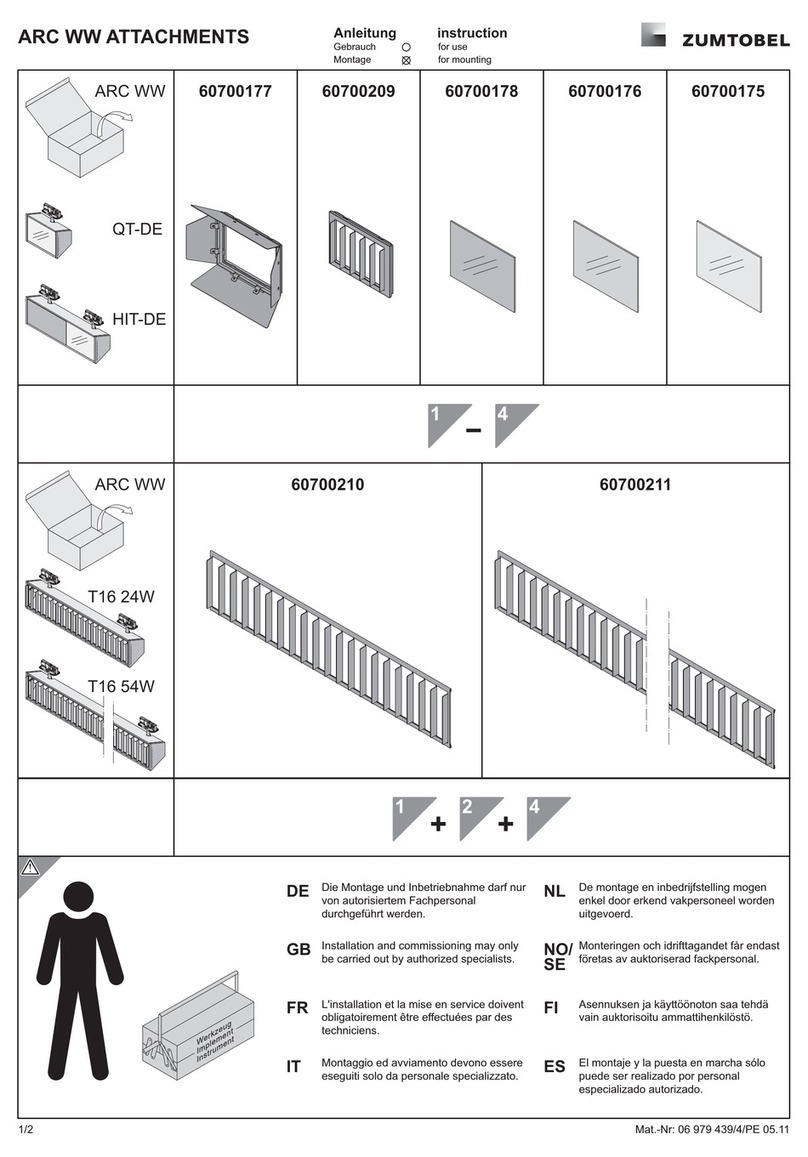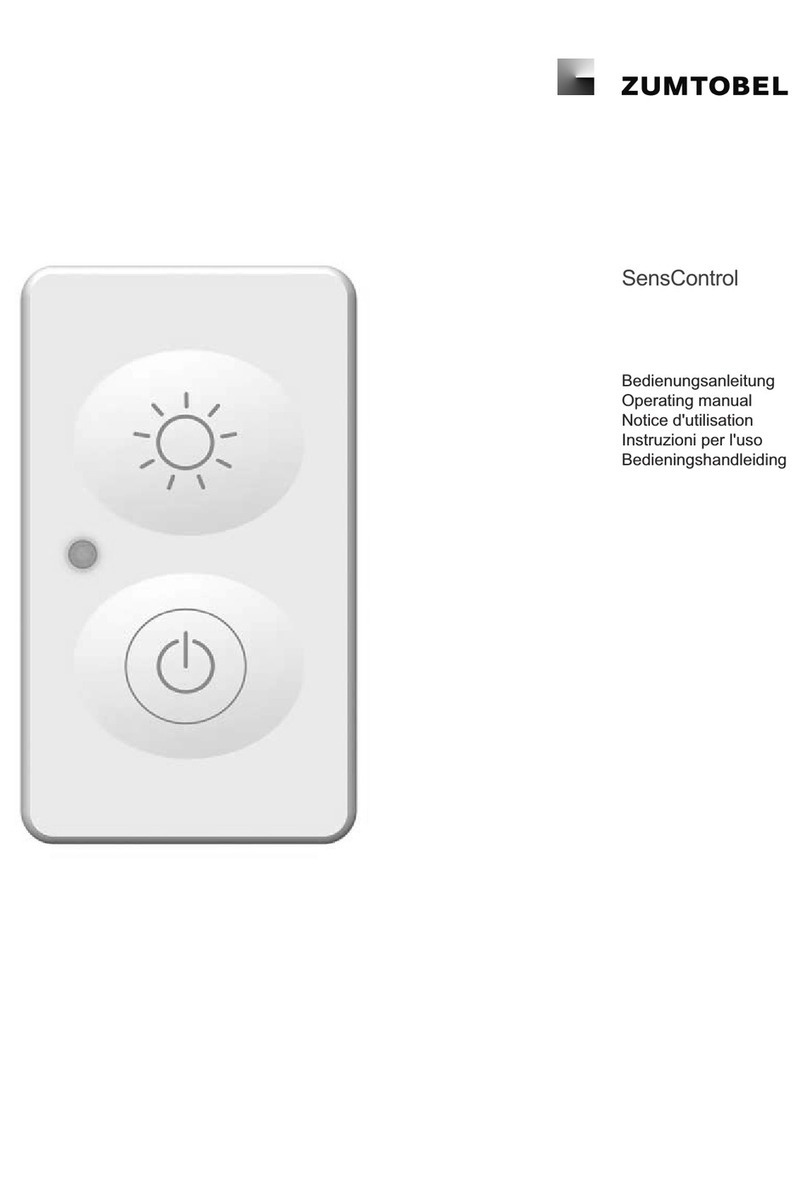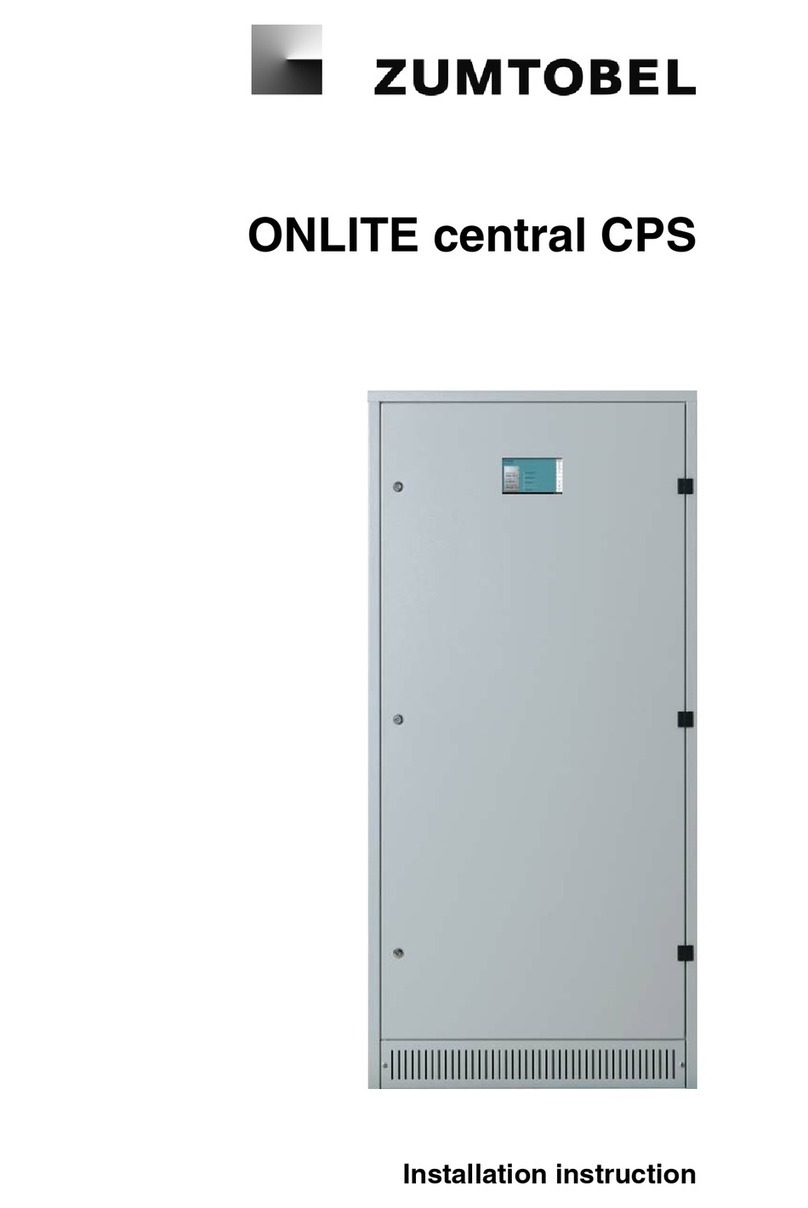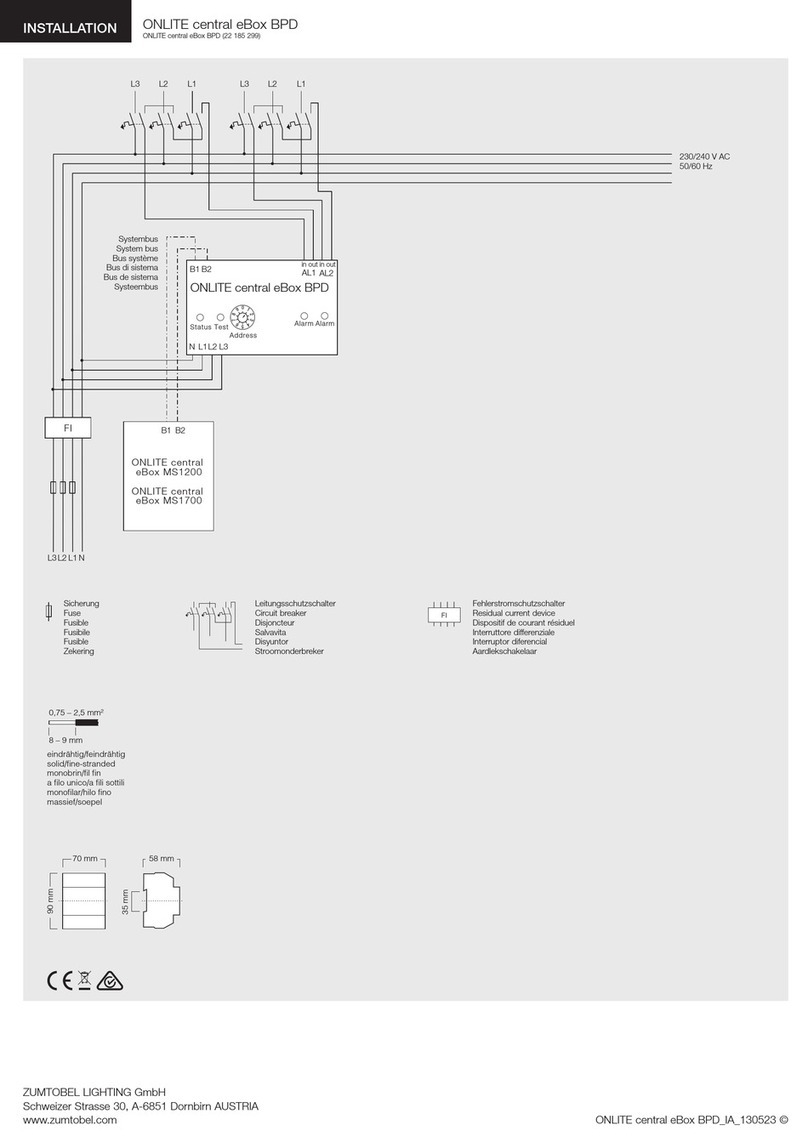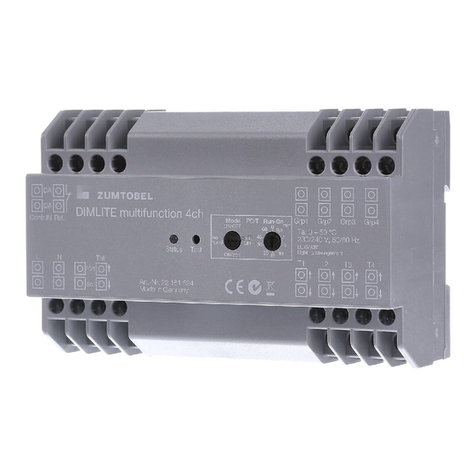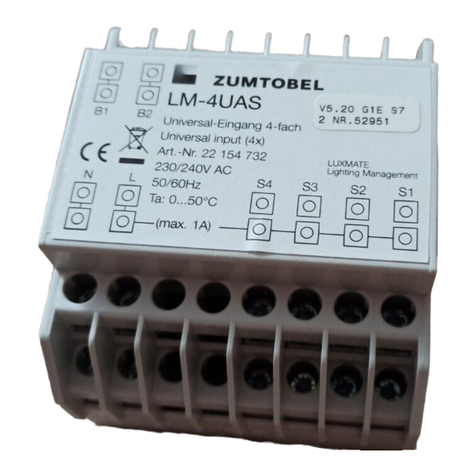
6
ZUMTOBEL Lighting GmbH
1. Consignes de sécurité
Pour le personnel électricien qualifié et le per-
sonnel instruit suivant la règlementation légale,
y compris les normes respectives ainsi que, le
cas échéant, CEI 60079-17 pour apppareils
électriques utilisables en atmosphère explosive.
Il n’est pas permis d’utiliser le luminaire dans la
zone 0.
L’appareil ne doit pas être mis en marche lorsque
l’épaisseur du dépôt de poussière est trop
importante (supérieur ou égal à, selon
EN 61241-0 et -1).
Les caractéristiques techniques indiquées
sur le luminaire doivent être respectées!
Il n’est pas permis de transformer ou de mo-
difier le luminaire!
Le luminaire ne doit être exploité que pour la
fonction qui lui est dévolue et qu’en état
intact et parfait!
Seules des pièces de rechange d’origine
ZUMTOBEL doivent être employées pour le
remplacement!
Des réparations qui portent sur la protection
contre l’explosion, ne doivent être exécutées
que par ZUMTOBEL ou par un «électricien»
qualifié et doivent ensuite être vérifiées par
un «expert»!
Ce mode d’emploi ne doit pas être laissé
dans le luminaire pendant son exploitation!
Veuillez respecter les prescriptions nationales de
sécurité et de prévoyance contre les accidents
ainsi que les consignes de sécurité qui sont
marquées d’un ( ) dans ce mode d’emploi!
1) Le rayonnement solaire intensive dans des régions à
température ambiante élevée peut provoquer à l’intérieur du
luminaire un échauffement extensif. Ceci peut impliquer une
réduction de durée de vie considérable. Pour pallier à cela, il
est préconiser d’utiliser un interrupteur photoélectrique.
4. Installation
Lors de l’installation et de l’exploitation
des appareils électriques pour
atmosphère explosive, les règlements
nationaux ainsi que les règles de la
technique généralement reconnues
doivent être respectés!
Le transport et le stockage ne sont permis que dans
l’emballage original et dans la position spécifiée!
Dimensions de fixation: voir fig. 1
L'intégrité de l'ajustage de précision peut
être compromise si les centres de
réparation ne sont pas correctement
alignés, voir fig. 9-11. Respecter lors de
la fixation des accessoires de montage au
luminaire que les trous de fixation doivent
avoir une profondeur du pas de 12 mm au
maxi.
Si le luminaire est installé avec la vasque
vers le haut, des précautions devront être
prises pour éviter l’accumulation d’eau au
niveau du joint de la vasque.
Accessoires pour le montage: voir le catalogue
ZUMTOBEL.
Ouverture et fermeture du luminaire
Tourner le verrou central avec la clé à douille
(ouverture de clé SW 13 Ord.No 32485000005) de
90°dans sa position de crantage et rabattre la
vasque de protection, voir fig. 2 et 3.
Monter et démonter la vasque de protection
suivant fig. 5 et 8.
La vasque de protection est pourvue d’une
charnière des deux côtés ce qui permet de la
suspendre de chaque côté.
Pour fermer le luminaire, presser la vasque de
protection contre le boîtier du luminaire et tourner le
verrou central de 90°.
Branchement sur secteur
Afin d’ouvrir la boîte de connexion, tourner la poignée
verte jusqu’à sa butée, puis la tirer et rabattre la
trappe, voir fig. 3 et 4.
Introduire le câble par l’entrée de câble Ex e, voir
fig. 4. Utiliser les deux joints d’étanchéité pour les
câbles de 8 à 12 mm, et le joint extérieur seul pour
les câbles de 12 à 17 mm.
Veiller au propre logement du joint d’étanchéité qui
demeure dans la presse-étoupe.
Connecter les câbles aux bornes PE, N, L1, (L, L2,
L3) suivant le repérage des bornes (voir schéma
des connexions sur page 2).
En cas d'occupation simple de la borne, il n'est
pas nécessaire de replier le conducteur (boucle!)
Serrer aussi les bornes non utilisées!
Attention
En cas d’entrées de câble non utilisées, leur
disque protecteur doit être enlevé, et
l’entrée doit être fermée avec un bouchon
de fermeture (couple de 3,5 Nm). En
fermant par un bouchon de fermeture,
toujours utiliser les deux joints
d’étanchéité!
En cas d’entrées de câble métalliques,
enlever les obturateurs protecteurs des
entrées non utilisées et les fermer avec
des bouchons de fermeture Ex certifiés!
2. Conformité avec les normes
Ce luminaire convient à l’utilisation dans les zones
1, 2 , 21 et 22 d’une atmosphère explosive selon
EN 60079-10-1 et EN 60079-10-2.
Le EVG intégré remplit les conditions du CEI 60079-7 ED.
d'ébauche 4 (EOL) et le CEI 61347-2-3 (§17.2 et §17.3).
Il a été conçu, construit et testé selon l’état actuel de
la technique et selon DIN EN ISO 9001:2008.
Dans des environnements particulièrement salissants
et avec dépôts de brouillards de peinture on pourra
utiliser un film de protection lavable de type „SLIME“
de la société 3M !
Attention ! cette application n’est pas autorisée
dans des zones contenant de la poussière
inflammable ( II 2 D).
Respectez les instructions du fabricant.
3. Caractéristiques techniques
Certificat d’essai CE du
modèle type: BVS 10 ATEX E154
Domaine II 2 G Ex de IIC T4
d’application: II 2 D Ex tD A21 IP66 T80 °C
Mode de protection:
Homologation de l’assurance de la qualité en
production: PTB 96 ATEX Q001-5
Classe d’isolation
selon EN /CEI60 598: I
Indice de protection selon
EN/CEI 60529: IP 66
Température ambiante 1)
KXA 2Un>220 V -25 °C à +55 °C
KXA 2Un<220 V -25 °C à +50 °C
KXA 2 2x58 W -25 °C à +40 °C
Température de stockage
dans l’emballage original: -25 °C à +60 °C
Capacité de serrage des bornes,
2 x par borne: unifilaire multifilaire
min. 1,5 mm21,5 mm2
max. 6,0 mm26,0 mm2
Section transversale du conducteur en
cas d’interconnexion:
2,5 mm
2
pour 16 A au maxi
Entrée de câble Ex-e:
modèle standard: M25x1,5 pour câbles
d’un modèle standard: d’un Ø de 8 à 17 mm
Couple d' essai pour l’entrée de câble
Ex-e M25x1,5: 5,0 Nm
Couple d' essai pour la
vis de pression: 3,5 Nm(pour étancher le
câble ou le bouchon de
fermeture)
Mise en place de la lampe
N’utiliser que des lampes homologuées
pour ces luminaires, voir Caractéristiques
techniques et plaque signalétique!
Lampe double broche (G13)
Introduire la lampe jusqu’à sa butée dans les deux
douilles selon fig. 6, de manière que les deux broches
de chaque côté de la lampe soient prises par la douille.
Puis tourner la lampe de 90° en position de crantage
selon fig. 7. Une surface verte dans la douille
deviendra alors visible. Maintenant la lampe est
protégée de tomber du luminaire.
5. Mise en service
Avant la mise en service des luminaires, il faut
vérifier s’ils sont branchés et fonctionnent en
conformité avec ce mode d’emploi et avec d’autres
règlements y applicables!
Des mesurages d’isolation ne doivent être effectués
qu’entre PE et le conducteur extérieur L1 (L’, L2, L3)
ainsi qu’entre PE et N!
– tension de mesurage: 1 kV CC au maxi
– courant de mesurage: 10 mA a maxi
Remplacement de la lampe: Respecer les intervalles
de remplacement selon L'indication du fabricant de
lampes!
6. Entretien
En ce qui concerne l’entretien, le test et
la ré•paration des appareils électriques
pour atmosphère explosive, les
règlements nationaux y applicables par
exemple CEI 60079-17 ainsi que les règles
de la technique généralement reconnues
devront être respectés!
Entretien
Lors de l’entretien surtout les composants dont
lesquels dépend le mode de protection contre
l’explosion, doivent être vérifié, par ex.:
Le boîtier et la vasque de protection présentent-ils
des fissures ou des signes d’avarie?
Les joints d’échantéité sont-ils efficaces?
Les bouchons d’obturation et les bornes sont-ils
bien serrés?
Vu le risque d’une charge électrostatique, le
luminaire ne doit être nettoyé qu’avec un chiffon
humide et non fibreux ou qu’avec une éponge!
Utiliser uniquement un détergent ménager dilué
avec de l’eau comme prescrit! La température de
l’eau ne doit pas dépasser 50°C au maxi. Rincer
ensuite à l’eau claire afin d’éviter que
n’apparaissent des fissures dues à la contreinte
exercée sur la vasque de protection!
Remplacement de la lampe: Respecer les
intervalles de remplacement selon L'indication du
fabricant de lampes!
Réparation
Avant de remplacer ou d’enlever des
composants, il faut observer le suivant:
Mettre l’appareil hors tension avant de
l’ouvrir ou de le réparer! N’utiliser que des
pièces de rechange approuvées d’origine
ZUMTOBEL !
(Voir liste des pièces de rechange
ZUMTOBEL)
Sous réserve de modification ou de supplément de
cette série de produits.
Quant à l’enlèvement des déchets, veuillez respecter
les règlements nationaux respectifs!
